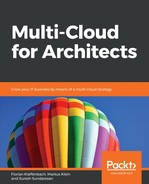Microsoft Exchange Server is a groupware and email solution that is, in Microsoft cloud technology, the technical basis of the Office 365 SaaS email functionality. If you decide to run Exchange Server on your own, the most recent release is Exchange Server 2019. And, in case it is needed, there is full support to run Exchange Server as virtual machines in your cloud environment.
Of course, it is possible to run a simple VM with all Exchange Services on it, but, like with almost every company groupware solution that requires high availability, there is the possibility to set up Exchange Server environments in a multi-server environment. As Exchange Server has to support low latency network environments by default, it supports running an Exchange Server environment in different networking regions. This means that you can set up some nodes of Exchange Server in cloud A, and the others in cloud B. This feature is called availability groups, too. A typical design would look as follows:

As you can see, the preceding diagram shows two Azure AD sites with redundancy, using Database Availability Groups (DAGs).
The best practice for running Exchange Server on AWS is illustrated as follows:

There is also a best practice design for Azure in hybrid cloud environments; it looks as follows:

A primary database residing on one Exchange mailbox server could have up to 16 database copies. The placement of these copies is dependent on the customer requirements.
As you have seen, configuring high availability within Exchange Server is the default, and it is quite easy to handle, too, from either the Exchange Server Management Console or from PowerShell.
